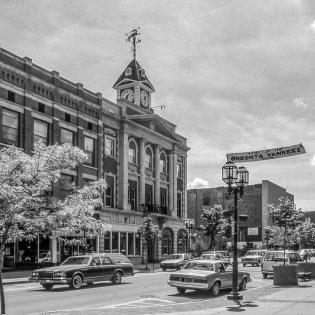What Would You Do Without Nonprofits? (6-8)
Students will describe how local nonprofits help the community.
The learner will:
- research nonprofit organizations in the community.
- identify the purpose of specific nonprofit organizations in the community using electronic and other media.
- graph the number of nonprofit organizations within the community.
- The Yellow Pages section from several telephone books
- Web site addresses of community foundations, for example www.guidestar.org or http://www.grfoundation.org/ or https://www.idealist.org/.
- Local periodicals and publications such as local magazines, programs from local symphonies, community bulletins, etc. (Teacher note: The local Chamber of Commerce is a good source for some of these materials.)
- Graph paper
- Are You Involved? (Attachment One)
- Nonprofit Organizations in my Community (Attachment Two)
- A community map projected for all to view
Have students bring the bar graph home. With an adult's help, the child and adult will discuss nonprofit organizations of which they are members, to which they contribute, or in which they participate. The child will add the number of organizations from each category in which they are involved to the graph titled Are You Involved? (see Attachment One).
Helpful Web sites include:
- Idealist.org – https://www.idealist.org/ - a project of Action Without Borders. Over 45,000 nonprofit and community organizations in 165 countries, which can be searched by name, location or mission. It also has information on volunteer opportunities in local communities and the world as well as a Nonprofit Career Center with hundreds of job and internship listings.H
- Learning to Give – www.learningtogive.org – Resource Room, Vocabulary
- GuideStar - https://www.guidestar.org/ – a web site focused on facilitating access to information about the operations and finances of nonprofit organizations.
- America’s Second Harvest Gleaners – www.gleaners.org
Instructions
Teacher note: The lessons in this unit are written with the understanding that students know the definitions of nonprofit and for profit organizations. Please see http://learningtogive.org/materials/vocabulary.asp if students need a better understanding of nonprofit or any associated vocabulary. To find the number of nonprofit organizations in the community, contact a local Chamber of Commerce, or search http://www.guidestar.org or https://www.idealist.org/
Choose a student to go to the board and point to the estimates students gave about nonprofits in the community. Ask the student to point to his/her number and tell the student whether his/her response is hot or cold according to how close the guess is to the actual number. Continue choosing students to play hot or cold until students have guessed the number correctly.
Brainstorm with students how nonprofit organizations could be classified. (If Lesson One was taught, you may want to use the list of nonprofit organizations the class generated.) Pose questions if students are having difficulties: "To what kind of organizations or causes does your family contributed money?" or "Has anyone donated money for causes in other countries?" Nonprofits can commonly be grouped by religious, public and societal benefit, health and human services, art, culture, and recreation, education, environmental, and international organizations. Use the Internet and the Web site https://www.guidestar.org/ or local publications to find information about local nonprofit organizations. Ask each student to think of an example in the community that would fit into one of the categories. For example, a student might say, "My YMCA camp would be an art, culture, recreational organization." Discuss how each organization helps the community. Identify the organization as providing a good or a service for the community. For example, Goodwill provides goods like clothing and household items and Boy Scouts of America provide services like raking yards and collecting items for the needy.
Distribute graph paper to each student. Label the horizontal line with the names of the nonprofit organizations, the vertical line with increments of 50, and title the graph Nonprofit Organizations in my Community. Have students use some of the above resources to identify how many nonprofit organizations are located within the community and how many specifically for each group. Create a bar graph with the information and draw pictures under each category that represent the meaning of each nonprofit group. An optional graph is located in Nonprofit Organizations in my Community (Attachment Two).
Pose the question, "How would the quality of life in our community change if we did not have nonprofit organizations?" Have students journal their thoughts and share their ideas.
Have students draw a picture of nonprofits in action, (i.e., using Habitat for Humanity, students could draw people building a house, or for the library it could be a picture of the building with people coming out carrying books). A sentence should be written and attached to each picture about why the organization is a nonprofit. The drawings could be made into a class mural or collage to hang in the hall or classroom.
Philanthropy Framework
-
Strand PHIL.II Philanthropy and Civil Society
-
Standard PCS 04. Philanthropy and Geography
-
Benchmark E.2 Identify and describe how civil society organizations help the community.
-
-
